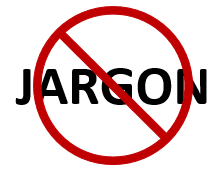- Why Back-Office Lending Automation Enhances Customer Satisfaction
- Coronavirus May Spur Capital Flight from U.S. and Weaken Dollar, Says MUFG Americas Head of Trading
- Trade Association Chief Warns US Days Away From 'Retail Armageddon'
- CHINA ALERT: What Factoring Companies and Banks Need to know About Financing in Asia
- Coronavirus Disaster: Why Firms Should Lead the Recovery
Figuring out the Finance Jargon
December 8, 2016
By Toby Dahm

Warning! The remainder of this paragraph is not intended to make sense, but to make a point. I want to touch base andempower you to buy-in to a paradigm shift that’s in the wheelhouse of our core competency. If you will drink the Kool-Aid, we can incorporate best practices and really move the needle. This thing is scalable, but we need to make hay while the sun shines.
While the statement above used a lot of words, it didn’t say anything. The writer may have had a clear concept that may have actually been solid, but the overuse of jargon made it totally incomprehensible. I’ve been in many meetings where this occurred. The jargon threw me off and I couldn’t catch up.
Every group has its own peculiar jargon. While this helps them streamline their insider communication, it throws any outsiders off and he/she will miss (or misinterpret) the point. In the commercial finance business, a lot of terms are used and it can get very confusing – even for those of us who have been in the field for decades.
Often Used Descriptions of What We Offer:
- Accounts Receivable Financing
- Asset Based Lending
- Discount Factoring
- Traditional Factoring
- Factoring
- Receivables Purchase
- Invoice Factoring
- Working Capital Financing
- Inventory Financing
- Purchase Order Financing
- Revolving Lines of Credit
- Trade Finance
This list sounds nearly as varied as Baskin Robbins menu! Do we really provide so many different solutions? Are there differences in these offers? In short, no. The different words are used to make an impression.
Four differences Among All of these Descriptions
- The broadest category is factoring. Factoring is a form of financing in which the lender advances funds to a client against an invoice (account receivable) that the client assigns to the lender. That concept is captured in six of the above descriptions.
- There is a distinction between the factoring and traditional factoring. Traditional factoring involves providing credit protection, and is a true sale of the invoice (account receivable) from the client to the factor. The factor takes greater risk and thus provides a higher value. The term “traditional” has its origin in its use in financing trade between the U.S. colonies and England. It was used to assure the English merchants of payment for goods shipped across the Atlantic. Traditional factoring proved to be extremely profitable and thus it evolved into today’s offer which is primarily a financing tool as opposed to its broader origin.
- Asset-based Lending. This concept is similar to factoring in that borrowing is based upon the value of certain assets, including accounts receivable. All of the lenders will advance against accounts receivable, with many also providing funds based upon the value of inventory, equipment, and commercial real estate. Because of the constant change in the value of accounts receivable and inventory, these lenders insist upon the borrower having a robust and accurate accounting system, which the lender audits frequently. This covers at least four of the above categories.
- The last category is trade finance. Most people think of international trade when they hear that term, but it is also applicable to domestic trade. It is any financing that facilitates a sale, so all of the above can be categorized as trade finance. It is important to distinguish between purchase order (PO) finance and inventory finance. There is often confusion about how these offerings work. Purchase order financing is a method of credit enhancement in which the purchase order lender assures the supplier of payment. The advance is conditioned upon the supplier performance (delivery) and is based upon the ultimate sale value of the client’s purchase order. Inventory financing can be a broader form of financing where the clients’ inventory is the basis of the funds advanced, regardless of whether that inventory relates to a specific purchase order.
So, the point of this is to not let the jargon throw you off. If you are seeking financing for your own business, or on behalf of a client or friend, it is important to assess what the true financing need is. Forget about the sea of terminology. If you have a short-term transactional need, an asset-based lender is probably not the right fit. That likely falls into the factoring and trade finance category. If you are looking for an ongoing source of funding to operate your business, that is likely to fall into the asset-based lending category.
The bottom line is to describe what you need and then listen to what the lender offers. Does it provide the funds when you need them? Are the costs in alignment with your need? You don’t want to pay for a long financing commitment if you only have a temporary need.
Whatever the financing is called, it must meet your need, be simple enough to manage within your current processes, and have a cost structure that fits the duration of your need.

